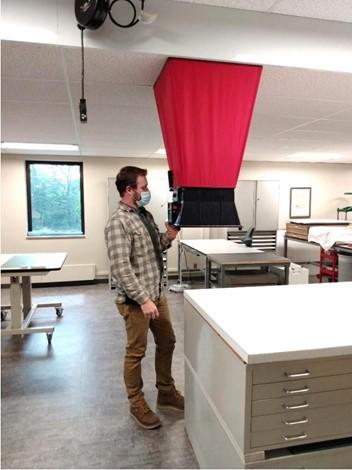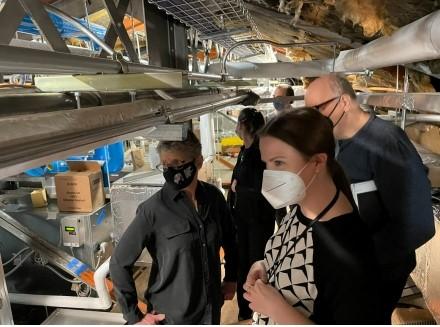Libraries Combating Climate Change

Rosenbach Museum and Library East Library. The library houses the museum’s rare book collection.

Rosenbach Museum and Library East Library. The library houses the museum’s rare book collection.
Cultural heritage collecting institutions are feeling the impacts of climate change, and many are grappling with ways to mitigate and adapt. As each year is named the new hottest on record and weather events and wildfires increase in severity and frequency, libraries are responding. By tapping into grant funding through NEH’s Sustaining Cultural Heritage Collections (SCHC) program, libraries are exploring and implementing environmentally sustainable preservation methods. This program helps cultural institutions meet the complex challenge of preserving large and diverse holdings of humanities materials for future generations by supporting environmentally sustainable preventive care measures that mitigate deterioration, prolong the useful life of collections, reduce energy consumption, and strengthen institutions’ ability to anticipate and respond to disasters.
The Rosenbach Museum and Library in Philadelphia was founded in 1954 by brothers A.S.W. and Philip Rosenbach. The nearly 400,000 collection items are housed in two historic townhomes. Highlights of the collection include Bram Stoker’s notes for Dracula, Thomas Jefferson’s comments on the Bill of Rights, James Joyce’s manuscript for Ulysses, large portions of the manuscripts of Charles Dickens’s Pickwick Papers and Nicholas Nickleby, the personal papers of Modernist poet Marianne Moore, and an early book print of the Bay Psalm Book published in 1640. The site also boasts a fine and decorative art collection. The Rosenbach was awarded a 2016 SCHC planning grant to assess environmental challenges in its collections spaces and to explore sustainable solutions to protect its collections. Drawing on recommendations and plans developed in the planning project, the Rosenbach was awarded an SCHC Implementation Level II grant in 2023 to install new LED lighting in two galleries and the period library, automate light fixtures throughout the period rooms, and install window light mitigation measures such as blinds, panels, and film. The new lighting and window treatments are expected to reduce light exposure to collections objects. The project will also reduce energy consumption; LED lighting uses less energy and produces less heat than incandescent and halogen bulbs and mitigating thermal gain through windows will reduce air conditioning use.
The Spencer Research Library at the University of Kansas is also the recipient of SCHC Planning and Implementation grants. Beginning in 2017, the Spencer Library worked with consultants to study the HVAC system serving storage spaces holding the rare books, manuscripts, and archival collections. The impressive collections include cuneiform tablets, eighteenth-century newspapers, publications relating to the history of science, printed ephemera from Central America, European Renaissance and Early Modern Books, manuscripts of contemporary science fiction authors, and the largest collection of rare Irish publications outside of Ireland. The project resulted in suggestions and priorities for optimizing the existing system and improving the preservation quality of Spencer Library’s collections spaces. Following the consultants’ recommendations, the Spencer Library’s 2020 Implementation project involved updating the HVAC system to provide a more optimal preservation environment for the collections while achieving a significant reduction in overall energy use and costs for the building. To learn more about this project, check out the Spencer Library’s blog post, Improving Energy Efficiency in Collection Storage in Spencer Research Library.
The New York Public Library (NYPL) is taking a holistic approach to addressing collection preservation needs, climate resiliency, and energy efficiency in three of the library’s research centers: the Stephen A. Schwartzman Building, the Library for the Performing Arts, and the Schomburg Center for Research in Black Culture. In 2021, NYPL received an SCHC Planning grant to develop a collections storage master plan. A key recommendation from the multidisciplinary team, which included collections staff, facilities staff, a mechanical engineer with expertise in sustainability, an architect, and sustainable preventive care consultants, [WM1] was to create a unified standard to guide capital projects in improving collections care and reducing energy use for the three research centers. NYPL received a second SCHC grant in 2024[WM2] to implement this recommendation. The Research Libraries Collection Spaces Construction Design Standard will establish environmentally sustainable standards to guide infrastructure improvements and preservation methods. The NYPL provides access to the 47 million items in its research collection to more than 11 million visitors each year primarily through its three main research libraries. The Stephen A. Schwartzman Building covers wide-ranging humanities subjects through literary manuscripts, rare books, prints, photographs, institutional records, and maps. The Library for the Performing Arts contains several divisions, including the Jerome Robbins Dance Division and the Rodgers and Hammerstein Archive of Recorded Sound. The Schomburg Center for Research in Black Culture provides access to archival materials, including the papers of Paul Robeson, Maya Angelou, and James Baldwin.
For information and ideas about actions your library can take toward becoming more sustainable, check out the Sustainable Libraries Initiative and the Council on Library and Information Resources (CLIR) Climate Resiliency Action Series.



